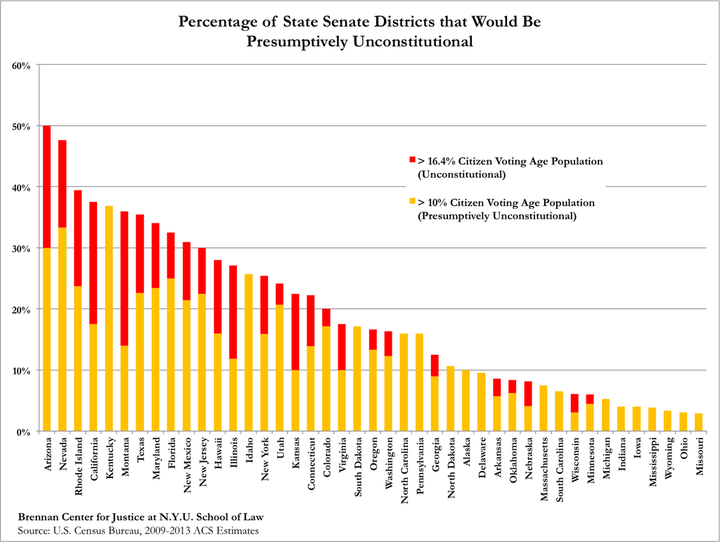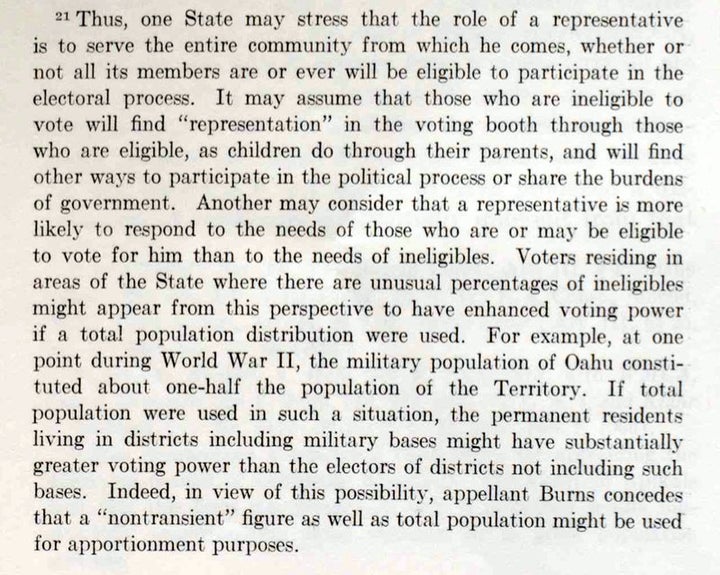
WASHINGTON -- Some 50 years ago, a Supreme Court footnote disappeared from the annals of history.
It wasn't a big deal then and it isn't today. Footnotes are hardly historic, let alone set precedent or redefine the meaning of the Constitution. They often just come and go in the process of horse-trading and consensus building among the justices, who may condition their votes on whether specific language goes or stays.
But as the Supreme Court gears up to tackle Evenwel v. Abbott, a politically charged voting rights case, this long-lost footnote from 1966 becomes more prescient than ever. And if history serves as a guide, its text could keep the court from a backlash and political consequences it doesn't need.
At the core of Evenwel, which the court hears on Tuesday, is the 14th Amendment's "one person, one vote" principle -- a tenet Americans understand to be fundamental as a matter of civics, even though few truly grasp what it means or where it came from.
Maybe the Constitution is to blame. "One person, one vote" is nowhere in its text. Yet the Supreme Court allowed it to creep in, little by little, starting with the landmark Baker v. Carr in 1962 -- a case Chief Justice Earl Warren came to regard as more important than even Brown v. Board of Education.
“Americans may know the 'one person, one vote' rule is fundamental as a matter of civics, but few truly grasp what it means or where it came from.”
Baker was one of those horse-trading cases. And it was a big deal at the time because with it -- and despite sharp internal divisions among the justices -- the court for the first time entered the "political thicket" of deciding state redistricting issues under the Constitution's equal protection clause.
Or as the court put it in Baker, the 14th Amendment requires that a person's right to vote be "free of arbitrary impairment by state action."
That sounds like a laudable result. But not so for Pepperdine University law professor Derek Muller, the discoverer of the lost footnote. His research has led him to conclude that Baker and the cases that followed it -- including 1964's Reynolds v. Sims, which cemented "one person, on vote" as a constitutional maxim -- were all a big mistake.
"These are very political cases," Muller told The Huffington Post. "For a long time they were deemed something politicians should decide, and not the court."
In an article to appear in the Harvard Journal of Law and Public Policy, Muller explains how the court went astray in these cases. And with his sights set on the Evenwel case, he argues that the dispute presents the Supreme Court with an opportunity to avoid the error of going back "to the judicial nationalization of state legislatures."
Evenwel is a dangerous case because the challengers -- two Republican voters from Texas with rather radical views -- essentially seek nationalization, except in a roundabout way. They want the justices to read the "one person, one vote" principle to prohibit states from drawing legislative districts based on total population, currently the most popular method. Instead, they argue the principle compels the creation of equal districts based on the total number of eligible voters in the state. All as a matter of constitutional law.
An analysis released by the liberal Brennan Center for Justice on Monday reveals to what extent this overhaul of "one person, one vote" would upend every state's electoral map, rendering them "presumptively unconstitutional" and in need of redrawing:

Seismic stuff. And a problem with such a sweeping result, as many election experts have observed, is that those hit hardest would include Latino immigrants and their families, children, people behind bars and those with mental illness. All stand to lose political clout if the Supreme Court blesses a rubric where only eligible voters count for map-drawing purposes. Are these groups not deserving of representation in the statehouse?
Places like Texas and New York have large concentrations of non-citizens that live in the bustling urban areas. Thus, states have an interest in reapportioning those districts to make sure they are represented. Does the Constitution really forbid them from doing that?
All questions with no easy answers. Which brings us back to the long-lost footnote.
Muller unearthed it when he dug through Supreme Court archives at the Library of Congress, with a special focus on the Baker case and others that followed. As he advances in his soon-to-be-published Harvard article, the footnote practically resolves the dispute in Evenwel and provides the Supreme Court with a clean, uncontroversial and deferential path that should help it steer clear of messy politics.
Here's what it looks like:

This footnote should have appeared in Burns v. Richardson, a 1966 redistricting case from Hawaii. The draft was circulated among the justices two weeks prior to the decision's announcement. But for some reason, it didn't make the cut.
Yale law professor Owen Fiss, who worked as a law clerk for Justice William Brennan, the author of the unanimous ruling in 1966, couldn't say why the footnote was left out. "I can't cast any light on this lost footnote," he told The Huffington Post.
A colleague of his in 1966, Peter Strauss, who now teaches at Columbia Law School, said that he was "not in a position to comment."
Burns matters because it was one of the court's final experiments with what Muller calls "federal judicial micromanagement" of state electoral maps -- the very thing Baker wrought in 1962. And what better state to rein in micromanagement than Hawaii, whose geography and sizable military presence -- the vast majority unregistered voters -- shifted the power dynamics in the state.
So the Supreme Court deferred to Hawaii. And the discarded footnote, in a symbolic way, aptly reflected the court's seeming change of heart. In the final opinion, right around where the footnote got cut, the court adopted the view that the ultimate "decision to include or exclude" an otherwise ineligible group "involves choices about the nature of representation with which we have been shown no constitutionally founded reason to interfere."
In other words: "Let's stay out of it and let the states decide for themselves."
Of course, the downside of a similar pronouncement in Evenwel is that states could run away with it and then have too much freedom to experiment with questionable apportionment schemes. So a rule of deference could cut both ways.
